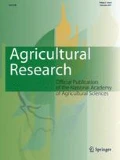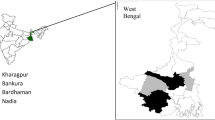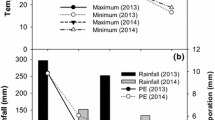Abstract
Irrigated rice is a luxurious consumer of water. Dry-seeded rice culture is an option that saves water, but may entail loss in crop yield implying a trade-off of productivity and water conservation. This study evaluates the water balance and productivity response of dry-seeded rice to management interventions using ORYZA2000 model. The database was generated from field studies involving combinations of planting dates and irrigation regimes. The performance of the model in simulating phenology, biomass, water use and yield was reasonable within the experimental conditions. The normalized root mean square of deviation (RMSDn) for simulated and measured harvest-time biomass and grain yield was 12 and 16%, while RMSDn for progressive soil water content and water use was less than 10%. Scenario analysis using historical weather data showed that rice planted on June 16 had minimum variance in potential yield (5.4%) compared to earlier (June 1) or later (July 1) planting. The evapotranspiration (ET)-based water productivity (WPET) was greater for June 16 and July 1 than June 1 planting. Loss of yield and WPET with reduction in irrigation frequency were least on June 16 rice implying this as optimal planting time of rice in the study region.


Similar content being viewed by others
References
Ahmed S, Humphreys E, Salim M, Chauhan BS (2014) Optimizing sowing management for short duration dry-seeded aman rice on the high Ganges river floodplains of Bangladesh. Field Crops Res 169:77–88
Arora VK (2006) Application of a rice growth and water balance model in an irrigated semi-arid subtropical environment. Agric Water Manag 83:51–57
Arora VK, Prihar SS, Gajri PR (1987) Synthesis of a simplified water use simulation model for predicting wheat yields. Water Resour Res 23:903–910
Bhushan L, Ladha JK, Gupta RK, Singh S, Tirol-Padre A, Saharawat YS, Gathala M, Pathak H (2007) Saving of water and labor in a rice-wheat system with no-tillage and direct seeding technologies. Agron J 99:1288–1296
Bouman BAM, Humphreys E, Tuong TP, Barker R (2007) Rice and water. Adv Agron 92:187–237
Bouman BAM, Kropff MJ, Tuong TP, Wopereis MCS, ten Berge HFM, van Laar HH (2001) Modelling lowland rice. International Rice Research Institute, Los Banos, Philippines; and Wageningen Univ Res Cen, Wageningen, p 235
Bouman BAM, Tuong TP (2001) Field water management to save water and increase its productivity in irrigated lowland rice. Agric Water Manag 49:11–30
Bouman BAM, Yang X, Wang H, Wang Z, Zhao J, Chen B (2006) Performance of aerobic rice varieties under irrigated conditions in north China. Field Crops Res 97:53–65
Feng L, Bouman BAM, Tuong TP, Cabangon RJ, Li Y, Lu G, Feng Y (2007) Exploring options to grow rice using less water in north China using a modeling approach. I. Field experiments and model evaluation. Agric Water Manag 88:1–13
Humphreys E, Kukal SS, Christen EW, Hira GS, Balwinder-Singh, Sudhir-Yadav, Sharma RK (2010) Halting the groundwater decline in north-west India—which crop technologies will be winners? Adv Agron 109:155–216
Joshi R (2013) Irrigation and deep tillage effects on water productivity of dry-seeded rice. Unpublished M.Sc. thesis, Punjab Agricultural University, Ludhiana, p 44
Kumar V, Ladha JK (2011) Direct seeding of rice: recent development and future research needs. Adv Agron 111:297–413
Manuja S, Shekhar J, Kumar A (2015) Performance of rice (Oryza sativa L.) varieties under aerobic cultivation in mid-hills of Himachal Pradesh. Himachal J Agric Res 41:160–162
Shekara BG, Sharnappa, Krishnamurthy N (2010) Effect of irrigation schedules on growth and yield of aerobic rice under varied levels of farmyard manure in Cauvery command area. Indian J Agron 55:35–39
Singh CB, Singh J (2016) Response of dry-seeded rice to sowing dates, irrigation regimes and cultivar duration. Agric Res J 53:334–341
Singh K (2011) Groundwater depletion in Punjab: measurement and countering strategies. Indian J Agric Econ 66:573–589
Sudhir-Yadav Gill G, Humphreys E, Kukal SS, Walia US (2011) Effect of water management on dry-seeded and puddled transplanted rice. Part 1: crop performance. Field Crops Res 120:123–132
Sudhir-Yadav, Humphreys E, Kukal SS, Gill G (2012) Evaluation of tradeoffs in land and water productivity of dry-seeded rice as affected by irrigation schedule. Field Crops Res 128:180–190
Wosten JHM, Pachepsky YA, Rawls WJ (2001) Pedotransfer functions: bridging the gap between available basic soil data and missing soil hydraulic characteristics. J Hydrol 251:123–150
Xue C, Yang X, Bouman BAM, Deng W, Zheng Q, Yan W, Zhang T, Rouzi A, Wang H (2008) Optimizing yield, water requirements, and water productivity of aerobic rice for the north China plain. Irrig Sci 26:459–474
Author information
Authors and Affiliations
Contributions
S Nisar conducted field experiment to generate database, did model evaluation work and prepared preliminary draft of the paper. VK Arora conceived the research problem, supplemented database from previous irrigation experiments, did preliminary modeling work and finalized the manuscript.
Corresponding author
Ethics declarations
Conflict of interest
There are no potential conflicts of interest.
Rights and permissions
About this article
Cite this article
Nisar, S., Arora, V.K. Analysing Dry-Seeded Rice Responses to Planting Time and Irrigation Regimes in a Subtropical Environment Using ORYZA2000 Model. Agric Res 7, 424–431 (2018). https://doi.org/10.1007/s40003-018-0331-9
Received:
Accepted:
Published:
Issue Date:
DOI: https://doi.org/10.1007/s40003-018-0331-9




